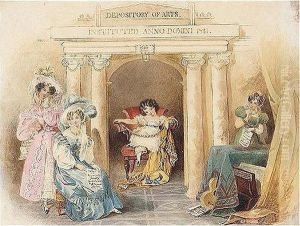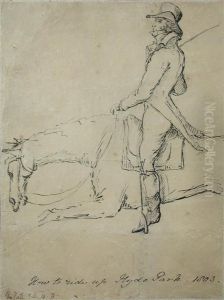Henry Edward, Sir Bunbury Paintings
Henry William Bunbury, known as Sir Henry Bunbury, was an English caricaturist and amateur artist, born in 1750. Although his formal title did not include 'Edward,' he is sometimes mistakenly referred to as 'Henry Edward Bunbury' due to confusion with other historical figures or a simple error in recording his name. Bunbury was born into an aristocratic family in Suffolk and was the second son of Sir William Bunbury, 5th Baronet, and his wife, Eleanor. Despite his family's position and wealth, Bunbury pursued a career in the arts, which was somewhat atypical for someone of his social standing.
Bunbury developed a keen interest in drawing at a young age and honed his skills over time. He was particularly drawn to the genre of satire and became well-known for his humorous and witty caricatures, which were popular among the British aristocracy. His work often poked fun at contemporary society, fashion, and the foibles of the upper classes, and he gained a reputation as a gentle satirist who could entertain without causing offense.
He married Catherine Horneck in 1781, with whom he had several children. His social connections and family background provided him access to many influential figures of his time, which often became the subjects of his caricatures. Despite his success as an artist, Bunbury never sought to make a livelihood from his art, instead creating works primarily for his own enjoyment and that of his friends.
Bunbury's caricatures were published in various forms, including single prints and illustrations for books. Some of his notable works include illustrations for Oliver Goldsmith's poem 'The Deserted Village' and the book 'An Academy for Grown Horsemen.' His style was characterized by a gentle, humorous portrayal of his subjects, with an emphasis on capturing the whimsical aspects of everyday life rather than overt political commentary.
Sir Henry Bunbury's legacy as an artist lies in the lighthearted and engaging nature of his caricatures. His work provides a valuable insight into the social mores and cultural attitudes of Georgian England. Bunbury died in 1811, leaving behind a body of work that continues to be appreciated for its historical and artistic value.



